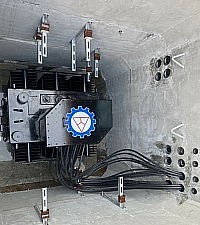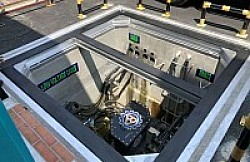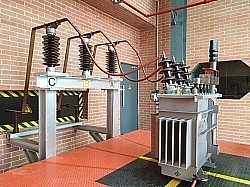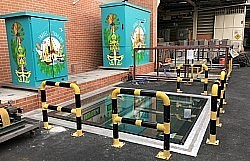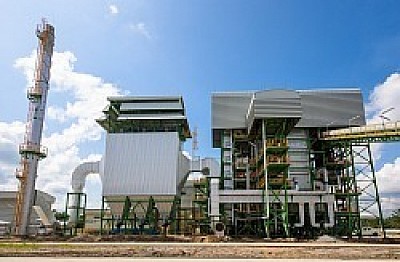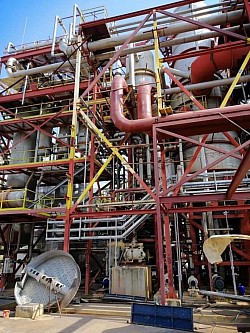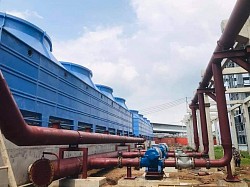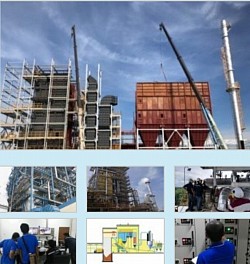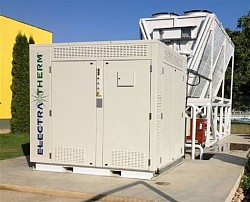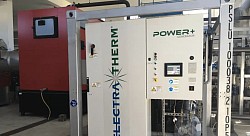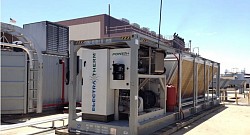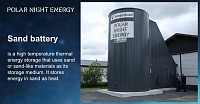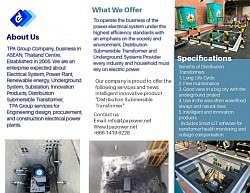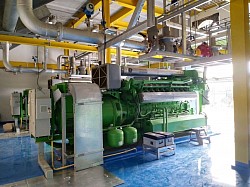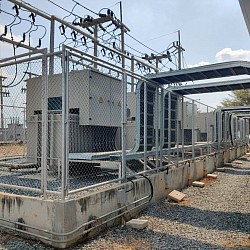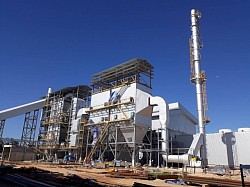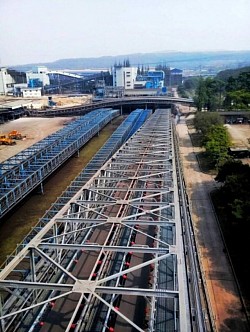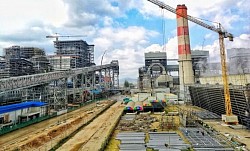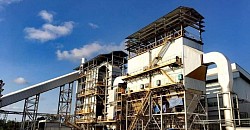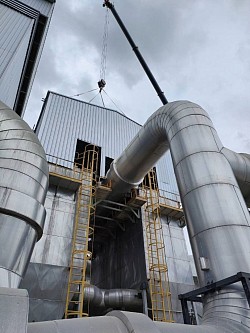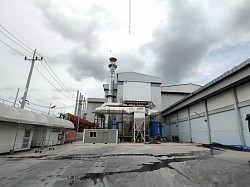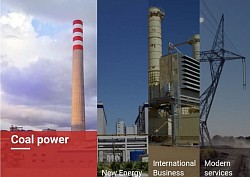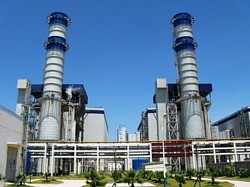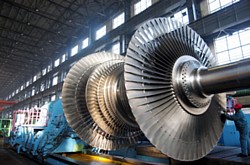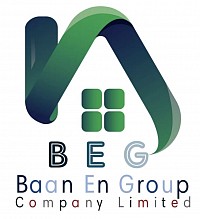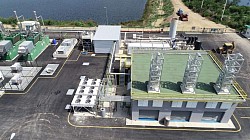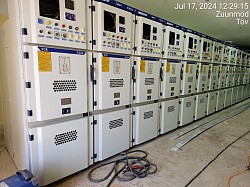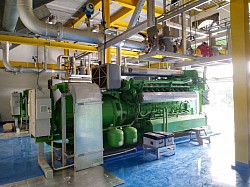Our Alliance and Innovation Technology
CCT Transformer-Submersible Transformer
To operate the business of the power plants under the highest efficiency standards with an emphasis on the society and environment, Electric Systems Provider
Biomass Plant
To operate the business of the power plants under the highest efficiency standards with an emphasis on the society and environment, Electric Systems Provider, Waste to Energy from the waste of municipal development to Electricity
ElectraTherm
Power GenerationEngine Waste Heat Recovery
Combustion engines see extensive use across the globe for their reliable power generation capabilities. From diesel prime power for remote power generation, gas compression, and providing power for industrial processes – combustion engines have the ability to generate anywhere from just a couple kilowatts to several megawatts of electricity. However, even with huge leaps in technology, gensets typically lose over 50% of the their input energy to waste heat.
ElectraTherm’s Organic Rankine Cycle (ORC) solutions, the Power+ Generator and Active Cooler, are able to capture and utilize this engine waste heat to increase efficiency up to 10%, which leads to significant energy savings. There are several other benefits such as reducing engine derate, remote generation of electricity, and even achieving net-zero cooling in addition to power generation.
Increase Efficiency
Decrease Costs
The graphic to the side represents the typical energy split in a combustion engine. As you can tell, a majority of the applied energy is lost as waste heat. ElectraTherm’s solutions convert engine waste heat – either from the jacket water or exhaust gas – into usable power. This process reduces the radiator cooling load and generates electricity that can be used to provide additional horsepower, improve the engine’s fuel economy, or sold for profit. By taking advantage of waste heat – and with no additional fuel consumption or emissions – efficiency is increased up to 10%.
Application: Boiler Process Heat, Biomass Heat Recovery
Power Output: Up to 180 kWe (2 units)
Hot Water Inlet Temperature: 116°C
Hot Water Flow Rate: 22 l/s
ElectraTherm, an industry leader in low temperature Organic Rankine Cycle (ORC) waste heat recovery, has successfully completed the installation of two Power+ Generator 6500’s on a biomass heat recovery application in Messina, Italy. The ORC system will utilize the residual heat from a large biomass boiler to generate electricity. At this site, woody biomass (hog fuel) fuels a boiler that heats water for process heat recovery using the Power+ Generator. The hot water enters the Power+ Generator at 116°C at 22 liters a second. When fully utilized at this site, each Power+ Generator 6500 is able to produce approximately 90 kWe.
Energy Storage, Sand Battery
What Is a ‘Sand Battery’?
A “sand battery” is a high temperature thermal energy storage that uses sand or sand-like materials as its storage medium. It stores energy in sand as heat. Its main purpose is to work as a high-power and high-capacity reservoir for excess wind and solar energy. The energy is stored as heat, which can be used to heat homes, or to provide hot steam and high temperature process heat to industries that are often fossil-fuel dependent.
As the world shifts towards higher and higher renewables fraction in electricity production, the intermittent nature of these energy sources cause challenges to energy networks. The sand battery helps to ambitiously upscale renewables production by ensuring there’s always a way to benefit from clean energy, even if the surplus is massive.
The term “sand battery” was introduced to grand audience by a BBC News story published the 5th of July 2022. The story was written by BBC News’ Environmental Correspondent Matt McGrath.
Read the story: BBC News: Climate change: 'Sand battery' could solve green energy's big problem
Watch the video: BBC News: How the world's first sand battery stores green power
What is the structure of your heat storage?
It is an insulated silo made of steel housing, filled with sand and heat transfer pipes. Additionally, equipment outside the storage is required, such as automation components, valves, a fan, and a heat exchanger or a steam generator.
How do you heat the sand?
With electricity from the grid or from local production, in both cases from fluctuating sources such as wind and solar. We charge it when clean and cheap electricity is available. The electrical energy is transferred to the heat storage using a closed loop air-pipe arrangement. Air is heated up using electrical resistors and circulated in the heat transfer piping.
How hot is the sand?
The maximum temperature heat storage is about 600 degrees Celsius. However, the temperature may even be higher depending on customer needs. In practice, the maximum temperature of a sand-based heat storage is not limited by the properties of the storage medium, but by the heat resistance of the materials used in the construction and control of the storage.
How do you get heat out of the heat storage?
The heat storage is unloaded by blowing cool air through the pipes. It heats up as it passes through the storage, and it can be used for example to convert waterĺĺpp0 into process steam or to heat district heating water in an air-to-water heat exchanger.
Why do you use sand?
Many solid materials, such as sand, can be heated to temperatures well above the boiling point of water. Sand-based heat storages can store several times the amount of energy that can be stored in a water tank of a similar size; this is thanks to the large temperature range allowed by the sand. So, it saves space and it allows versatile use in many industrial applications.
What kind of a sand you are using?
The heat storage is not very sensitive to sand grain size. We prefer high density, low-cost materials that are not from scarce sources. Someone else’s dirt could be our heat storage medium. We prefer to use materials that are not suitable for construction industry.
You can read more about our thermal energy storage medium from this blog post: Polar Night Energy’s Sand Battery Doesn’t Cause Sand Shortage – Thermal Energy Storage Medium Explained.
Does it matter what the grain size of the sand is?
Not much, we prefer to use those grain sizes that are not suitable for construction industry.
How is the heat storage insulated?
The heat storage is made of steel and insulated with standard, heat resistant insulating materials. The insulation is all around the heat storage between the outer steel layer and the inner one.
How long does the sand stay hot in the winter?
It can stay hot for months if needed, but the actual use case of the heat storage in to charge it in about 2-week cycles. The heat storage has its best range of use when it is charged and discharged 20 to 200 times per year, depending on the application.
You can read more about the efficiency of the thermal energy storage from this blog post: Sand Battery’s Efficiency Explained – Polar Night Energy’s ‘Sand Battery’ Has Efficiency Up To 95 Per Cent.
Is the outer surface of the heat storage hot?
The surface of the storage is not hot, because the heat stays inside the storage—where it should be.
Can it store electricity?
Not as such, as it stores energy in the form of heat. The heat can be connverted back to electricity using turbines like the ORC-turbine or a steam turbine. This requires additional investments to the turbine technology, and the conversion to electricity has inherent losses, thus complicating the economical side.
Is this a new technology?
Well, yes and no. The idea of heating sand to store energy is not new. Our way of doing things and commercializing it in large scale applications is.
Who are your clients?
We serve a wide range of different businesses and industries. For example, energy utilities, residential & commercial building operators, food & beverages, textile & clothing, chemistry & pharma, metal production and pulp & paper and other industries.
How can our company start a heat storage project with Polar Night Energy?
Please contact our Product Sales Manager Matti Ulvinen: send an email to matti.ulvinen@pne.fi or call +358 40 838 5767.
SPCPOWER
SPC POWER provides a wide range of Engineering, Procurement and Construction (EPC) services to support develops of new plants or operators expanding the capacity of existing facilities. Our skilled project teams deliver project-specific or turnkey sugar mill, power & utilities, renewable energy, biotechnology solutions. We have extensive experience in identifying, evaluating and recommending new or previously owned OEM equipment including Boiler, turbines, generators, transformers and E&IC across all phases of project development.
Our in-house knowledge covers balance-of-plant systems including boiler, HRSGs, condensers, fuel handling systems, precipitators, ash handling systems, water treatment plants, electrical & control systems, switch gear, and all fluid and gas processes, as well as the core rotating shaft equipment and MSW treatment plant.
Our experience includes Biomass power plant, MSW power plant, MSW treatment plant, Waste to energy power plant, Sugar mill plant project.
SPC POWER modular design strategy enables us to deliver integrated EPC services to construct power plant in Biomass, MSW, Waste to energy and Sugar mill plant configurations. We implement tested and proven processes to provide fast-track reliable power solutions.
These services include plant removal, relocation and reassembly services for existing power plants. From small industrials to large frame-type steam & gas turbines and everything in between, our relocation and construction teams are capable of completing the most challenging assignment.
Baan En Group Company
Engineering Fields for Baan En Group Company Limited (BEG), covering Sugar Plant, Power Plant, Cement Plant, and the various engineering disciplines involve
BEG’s Engineering Expertise
Overview of BEG: Highlight BEG’s establishment by Thai engineers and its full spectrum of engineering expertise.
Key Services: Mechanical Engineering, Power Electrical Engineering, Structural Engineering.
Industries Served: Sugar Plants, Power Plants, Cement Plants, and beyond.
Overview: Description of sugar production process and the engineering challenges.
Mechanical Engineering: Role in equipment design, mill machinery, conveyors, and piping systems.
Power Electrical Engineering: Power distribution systems, electrical control systems, motor drive control for milling and refining.
Structural Engineering: Design of industrial buildings, foundation support for heavy machinery, and load-bearing structures.
Sustainability: Incorporating renewable energy (biomass, cogeneration) in sugar plants.
Power Plant Engineering
Power Electrical Engineering: Design of high-voltage transmission systems, power generation control, and switchgear.
Structural Engineering: Foundation for heavy equipment, towers, control rooms, and safety structures
Mechanical Engineering: Role in the design of crushers, mills, kiln systems, and material handling equipment.
Power Electrical Engineering: Power supply management, motor control systems for grinders, mixers, and fans.
Power Generation & Distribution: High-efficiency electrical systems for power plants and industrial applications.
Automation & Control: Integration of automation for process optimization, SCADA systems, and control systems.
Renewable Integration: Incorporating solar, wind, or hybrid systems in traditional setups.
